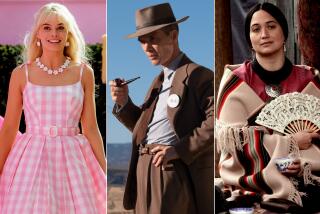Valentino returns, magnetism and all
- Share via
Not only did he have “It,” Rudolph Valentino also possessed the “S” factor -- he was sexy, sensuous, smoldering and swarthy. The original “Latin Lover” and the screen’s first superstar, the Italian-born actor still mesmerizes audiences 81 years after his untimely death of a perforated ulcer at the age of 31.
Though Flicker Alley’s new “Valentino” collection doesn’t feature his best-known films, such as “The Four Horsemen of the Apocalypse,” “Blood and Sand,” “The Sheik” and his final film, “Son of the Sheik,” the four-film disc, arriving Tuesday, is a great example of Valentino’s enduring screen magnetism.
Born Rodolfo Alfonzo Raffaelo Pierre Filibert Guglielmi di Valentina d’Antonguolla to a middle-class Italian family, Valentino attended agricultural college in Italy before moving to Paris to try his luck as a dancer. Making his living as a gigolo and cafe dancer, he eventually fled to New York after being involved in a scandal with a wealthy married woman.
He worked as a gardener, waiter and dancer before he came to California. He soon started making films -- as Rudolpho De Valentina -- and was generally cast as the handsome but sleazy villain.
It was June Mathis, one of Metro’s top writers, who saw his potential as a leading man and had him cast in Rex Ingram’s “The Four Horsemen of the Apocalypse.” The film was a huge hit, and the newly named Rudolph Valentino was an overnight sensation.
The new disc’s four digitally restored Valentino vehicles, which premiered last year on Turner Classic Movies, had been considered lost.
“A Society Sensation,” from 1918, marked his feature debut. Though the film is forgettable, Valentino isn’t. Even at 22, he exudes a sexuality rarely seen on the screen at that time. The actor is cast as Dick Bradley, the son of a wealthy San Francisco family who falls in love with Sydney (Carmel Myers), a young woman being introduced into society. The relationship stumbles over a misunderstanding regarding Dick’s heritage, then Sydney is kidnapped by a fisherman (Fred Kelsey) who also loves her.
Billed as Rudolf Valentine in 1920’s “Stolen Moments,” the actor is perfectly cast as an oily gigolo who attempts to blackmail a former lover (Marguerite Namara). This was Valentino’s last bad-guy role -- he made the film right before “Apocalypse” and superstardom. The movie was made as a showcase for Namara, who was a popular pianist and singer of the era, but it didn’t catch fire. In 1922, it was reedited from 60 minutes to just over 30; Namara’s role was cut significantly in this new version and Valentino was given top billing.
In his 1922 “autobiography” that was published in Movie Weekly, Valentino admitted he was glad to leave his villain days behind: “I was selected for villains because of my dark complexion and somewhat foreign aspect, I presume. This was a cause of regret to me, for I realized that the ‘heavy’ man has usually slight chance of attaining the most profitable and desirable positions in motion-picture acting, in spite of the artistic effort frequently needed for such roles.”
Though “Horsemen” and “The Sheik” both made female hearts flutter, male moviegoers thought Valentino’s image was effete. So Valentino followed up “The Sheik” with 1922’s seafaring adventure “Moran of the Lady Letty.” And though it isn’t as fun as “The Sheik,” Valentino does cut a virile swath as Ramon Laredo, a self-centered San Francisco aristocrat who is shanghaied at the docks and forced to work as a sailor. Dorothy Dalton, who received top billing, plays Moran, a beautiful woman who sails with her father on the Lady Letty, a ship that is commandeered by Laredo’s captain. Ramon falls for the young woman and defends her honor when the captain tries to seduce her.
The film received mixed reviews, though Variety said that “as a rough-and-tumble fighting hero, Valentino is a revelation.” Valentino wasn’t fond of the film because he thought playing a regular person diminished his sex appeal.
The rarest film in the set is 1922’s lavish “The Young Rajah.” The complete production has been lost for many years, but recently 16-millimeter fragments were found. For this edition, Flicker Alley’s Jeffrey Masino used those segments, two different theatrical preview trailers, still photographs and other records to try to re-create what the original film was like.
Even in its bizarre and truncated form, “The Young Rajah” is a hoot. Valentino plays Amos -- yes, Amos! -- Judd, a young Indian prince with psychic powers who, through several plot twists, ends up living with an American couple. Though the story machinations get sillier and sillier, Valentino is a real charmer.
Valentino’s sudden death in 1926 allegedly caused women to commit suicide in grief. Hit songs were written about his demise. Thousands of fans lined streets in Beverly Hills and Hollywood to watch the funeral procession. And every year, on Aug. 23 at 12:10 p.m. -- the time of his death -- there is a memorial service at the Hollywood Forever Cemetery, where he is interred. This year, 200 faithful attended.
--
More to Read
Only good movies
Get the Indie Focus newsletter, Mark Olsen's weekly guide to the world of cinema.
You may occasionally receive promotional content from the Los Angeles Times.











